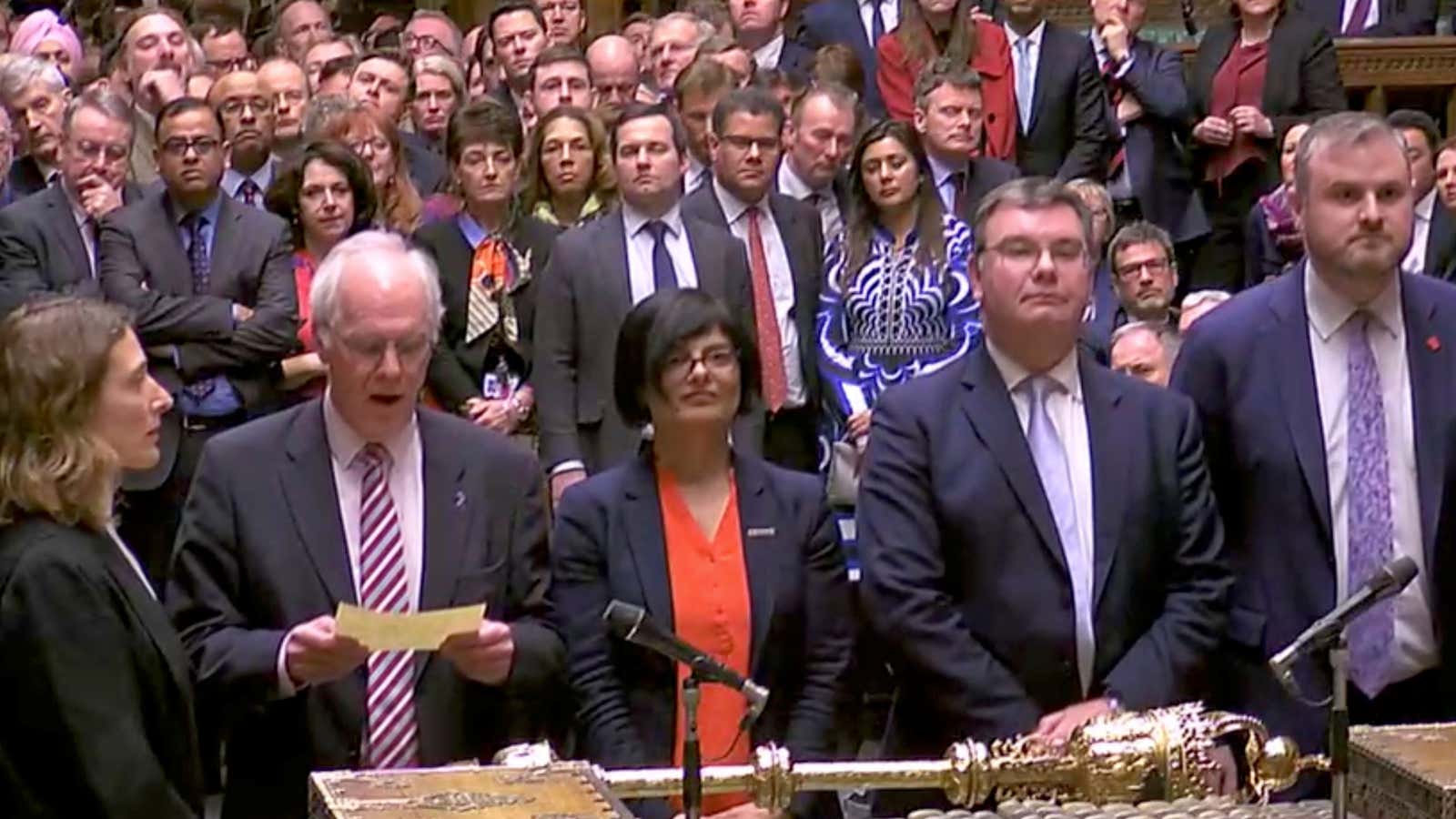The UK parliament takes voting seriously—it has records of parliamentary petitions stretching back to medieval times. While this has made for a very robust democratic system, the consequence, as Brexit has made clear, is that the process of lawmaking can be quite confusing in a country that lacks a codified constitution.
The UK public voted in a referendum to leave the European Union almost three years ago. Since then, parliament has held a series of votes to try determine the terms and timing of the UK’s departure from the EU, originally scheduled for March 29. Lawmakers haven’t reached an agreement on any particular path, forcing the government to request a delay to Brexit day.
Members of parliament have twice rejected prime minister Theresa May’s proposed deal to transition the UK out of the EU in “meaningful” votes. They’ve expressed their opinion on a no-deal Brexit—leaving without any sort of transitional arrangement—in a “free” vote. Hundreds of thousands of people marched in London over the weekend calling for a “People’s Vote.” Last night, MPs agreed to hold a series of “indicative” votes on alternatives to May’s withdrawal agreement.
What makes a vote meaningful? Indicative? Free? Read on.
What is an indicative vote?
MPs voted last night to hold a series of “indicative votes” tomorrow (March 27) on alternative approaches to Brexit, effectively wrestling control of the process from May’s government, which normally determines the business of parliament. The votes are not legally binding but have political weight, and ideally should provide a signal of the divorce deal that is most palatable to MPs. Among the options MPs might vote for: exiting without a deal, exiting according to May’s deal, joining a customs union with EU, joining the EU’s single market, or holding a second referendum on whether to leave at all.
“The Government is not usually bound by indicative votes, unless it has agreed to be so beforehand,” the Institute for Government explains. “Even if indicative votes demonstrated a parliamentary majority in favor of a particular Brexit stance, there is no guarantee that the Government would adopt it in negotiations with the EU, although the political pressure to do so would be very high.”
May has expressed skepticism about whether indicative votes can deliver a meaningful outcome—it’s possible that none will garner a majority. And even if a majority of MPs agree on a way forward, the prime minister won’t commit to delivering on it.
What is a meaningful vote?
This is essentially a process intended to give parliament a proactive say on the terms under which the UK departs the EU before they are finalized. Parliament has historically been allowed to state its opinion on treaties which may, or may not, alter the government’s approach. Given the incredible importance of Brexit to the UK’s future, an arrangement was made to give a “meaningful vote” on the UK-EU withdrawal agreement more significance and sway. The parliament’s rejection of May’s deal in two meaningful votes meant she could not proceed with its implementation without making changes and resubmitting the package to MPs for approval.
What is a free vote?
This allows a member of parliament to vote “according to their conscience,” instead of along party lines. Typically, party members are “whipped” (ordered by their party leadership) to vote a certain way, or face consequences like losing committee positions or cabinet posts. In some cases, as when May asked MPs to vote on a no-deal Brexit, they may be allowed to break with their party.
Free votes recognize that party members may have differing views on ethical issues. In the past, free votes have been held on assisted dying, fox hunting, same-sex marriage, and—somewhat ironically—whether to join the European Economic Community in 1971, the precursor to the EU.
Oh, also, indicative votes are sometimes free votes.
What about the “People’s Vote”?
This is a catchy phrase used by supporters for a second Brexit referendum. A referendum refers officially to a choice that is put to the entire voting public, as the question of whether to remain in the EU was in 2016. Some people consider them a terrible idea. “Referendums are messy, dangerous and not nearly as democratic as they seem,” write New York Times columnists. They “tend to be volatile, turning on unrelated political swings—or even the weather… and they are poor tools for measuring public opinion.”
But if that’s the case, supporters of a People’s Vote might argue, better to try a second time than rely on the results of one, narrowly decided referendum a few years ago. “One thing unites everyone who backed Leave or Remain in 2016,” supporters of a second referendum say. “Nobody voted for this botched Brexit.”
